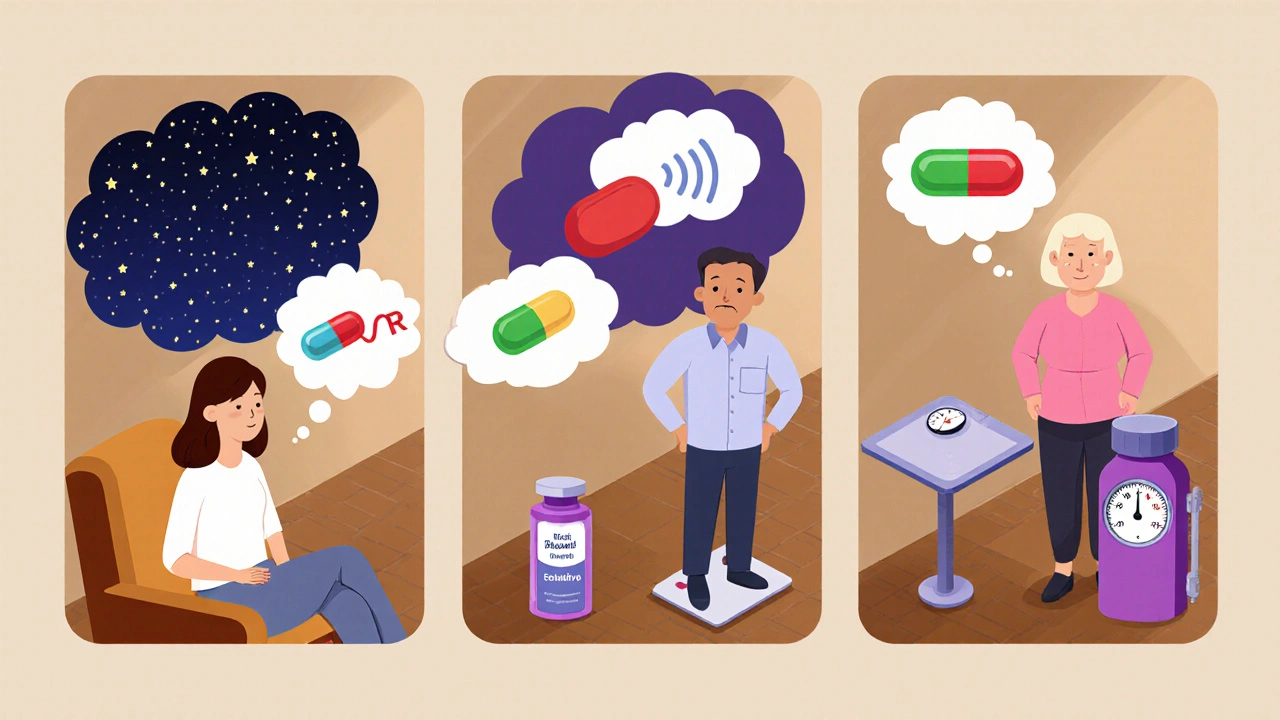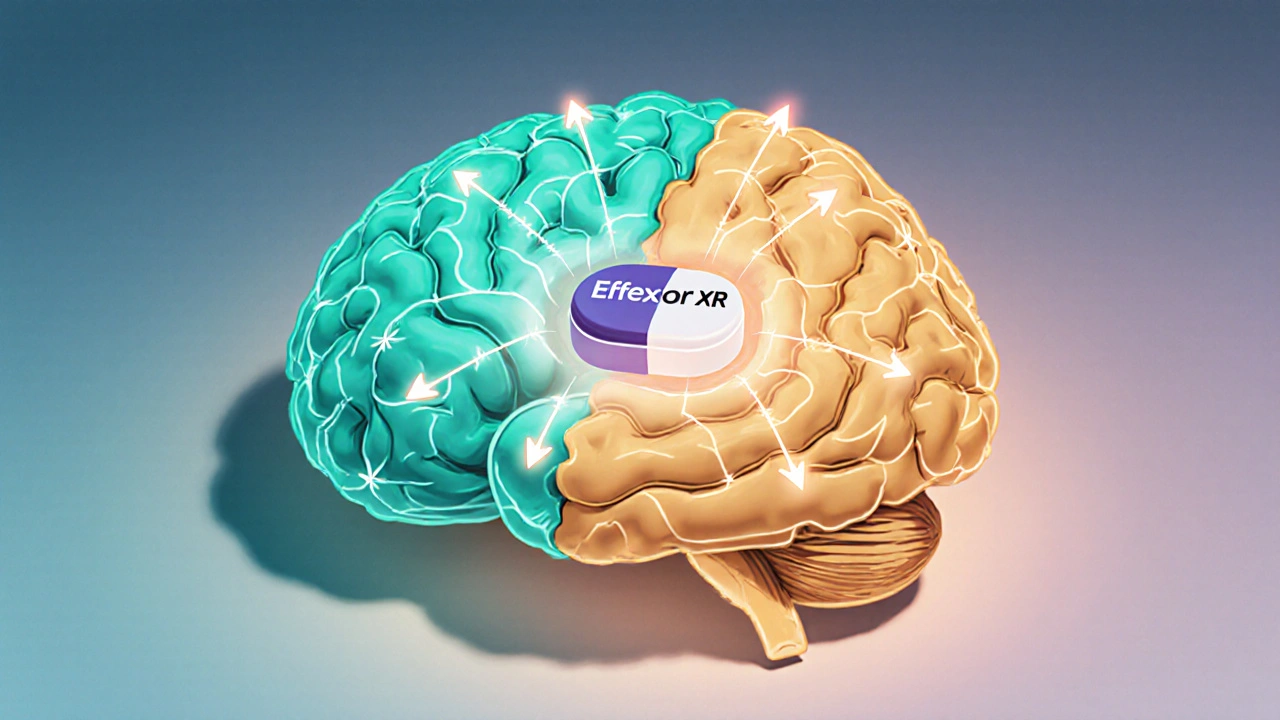Antidepressant Medication Comparison Tool
Find Your Best Depression Medication Match
Answer a few questions about your symptoms and concerns to see which antidepressant might work best for you.
Your results will appear here after clicking the button
When a doctor prescribes a medication for depression, patients often wonder how Effexor XR comparison stacks up against other options. Is it the right fit for you, or would a different pill work better? This guide breaks down Effexor XR (Venlafaxine) and lines it up with the most common alternatives, so you can see the real differences in how they act, what side‑effects to expect, and what factors matter most when choosing a treatment.
What Is Effexor XR (Venlafaxine)?
Effexor XR (Venlafaxine) is a prescription medication classified as a serotonin‑norepinephrine reuptake inhibitor (SNRI). It works by boosting the levels of two brain chemicals - serotonin and norepinephrine - that help regulate mood, anxiety, and pain.
Venlafaxine was first approved in the United Kingdom in 1993 and has since become a go‑to choice for major depressive disorder (MDD), generalized anxiety disorder (GAD), and certain pain conditions. The “XR” stands for extended‑release, meaning the tablet releases the drug slowly over 24 hours, which helps keep blood levels steady and reduces the need for multiple daily doses.
How Effexor XR Works Compared to Other Classes
Antidepressants fall into several broad families. The two most common groups are:
- Selective serotonin reuptake inhibitors (SSRIs) - they increase serotonin only.
- Serotonin‑norepinephrine reuptake inhibitors (SNRIs) - they raise both serotonin and norepinephrine.
Because Venlafaxine hits two neurotransmitters, it can be more effective for people whose depression is linked to low energy or chronic pain. However, that dual action also brings a distinct side‑effect profile.
Key Benefits and Drawbacks of Effexor XR
Benefits
- Broad symptom coverage: Improves mood, anxiety, and physical pain simultaneously.
- Once‑daily dosing: The extended‑release formulation simplifies the regimen.
- Proven efficacy: Large clinical trials show response rates around 55‑60 % for moderate‑to‑severe depression.
Common drawbacks
- Higher risk of blood‑pressure increase, especially at doses above 150 mg/day.
- Potential for withdrawal symptoms if stopped abruptly - think flu‑like aches, dizziness, or “brain zaps.”
- Sexual side‑effects (reduced libido, delayed orgasm) can be more pronounced than with many SSRIs.
Popular Alternatives to Effexor XR
Below are the five most frequently prescribed antidepressants that patients compare with Venlafaxine. Each has its own class, dosing range, and side‑effect quirks.
Fluoxetine (brand name Prozac) - an SSRI that’s been on the market since the late 1980s.
Sertraline (Zoloft) - another SSRI, popular for its relatively mild weight‑gain risk.
Duloxetine (Cymbalta) - an SNRI with a slightly stronger impact on pain relief.
Paroxetine (Paxil) - an SSRI often chosen for anxiety‑dominant presentations.
Escitalopram (Lexapro) - an SSRI praised for its tolerability and low interaction potential.
Side‑Effect Snapshot: How the Drugs Differ
| Medication | Class | Typical Daily Dose | Common Side‑effects | Weight‑gain Risk | Sexual Side‑effects | Average Monthly Cost (GBP) |
|---|---|---|---|---|---|---|
| Effexor XR (Venlafaxine) | SNRI | 75‑225 mg | Hypertension, nausea, insomnia | Low‑moderate | High | £25‑£40 |
| Fluoxetine (Prozac) | SSRI | 20‑60 mg | Insomnia, GI upset, anxiety | Low | Moderate | £15‑£30 |
| Sertraline (Zoloft) | SSRI | 50‑200 mg | Diarrhea, dry mouth, dizziness | Low | Moderate | £18‑£35 |
| Duloxetine (Cymbalta) | SNRI | 30‑120 mg | Hypertension, constipation, fatigue | Low‑moderate | Moderate‑high | £30‑£45 |
| Paroxetine (Paxil) | SSRI | 20‑50 mg | Weight gain, drowsiness, withdrawal | High | High | £12‑£25 |
| Escitalopram (Lexapro) | SSRI | 10‑20 mg | Nausea, fatigue, sweating | Low | Low‑moderate | £20‑£38 |
Choosing the Right Medication - Five Practical Factors
- Primary symptom focus: If pain or low energy dominate, an SNRI like Venlafaxine or Duloxetine may outperform an SSRI.
- Blood‑pressure concerns: People with hypertension should monitor doses above 150 mg of Venlafaxine closely or consider an SSRI.
- Sexual side‑effects tolerance: Patients who find sexual dysfunction a deal‑breaker often prefer Escitalopram or Fluoxetine, which tend to have milder impacts.
- Withdrawal risk: Paroxetine is notorious for withdrawal, while Venlafaxine also needs a slow taper. If you want a smoother stop, Fluoxetine’s long half‑life is advantageous.
- Cost and insurance coverage: Generic versions of Fluoxetine and Sertraline are usually cheapest. If budget is tight, these may be first‑line before moving to brand‑name SNRIs.
Real‑World Scenarios - Which Drug Might Fit?
Case 1: Emily, 28, struggles with anxiety‑driven insomnia. Her doctor started her on Effexor XR 75 mg. Within two weeks, Emily reported less anxiety but found the tablet made her feel jittery at night. Switching to Sertraline 50 mg resolved the insomnia without sacrificing mood improvement.
Case 2: Mark, 45, has major depression plus chronic lower‑back pain. An SNRI was essential. He tried Duloxetine 60 mg and saw both mood and pain improve, while Venlafaxine caused a noticeable rise in blood pressure, prompting a dose reduction and eventual move to Duloxetine.
Case 3: Sarah, 62, worries about weight gain. She was prescribed Paroxetine but gained 4 kg in three months. Switching to Escitalopram kept her mood stable and prevented further weight change.

How to Transition Between Medications Safely
Never stop an antidepressant cold turkey. A typical taper looks like this:
- Week 1‑2: Reduce dose by 25 %.
- Week 3‑4: Reduce another 25 %.
- Weeks 5‑6: Continue reducing until you reach the lowest available tablet.
- After the final dose, wait 1‑2 weeks before starting the new medication, unless the new drug has a long half‑life (e.g., Fluoxetine) which can overlap safely.
Always follow the prescriber’s plan and report new symptoms promptly.
Frequently Asked Questions
Frequently Asked Questions
Can I take Effexor XR with alcohol?
Mixing alcohol with Venlafaxine can increase drowsiness and worsen depression symptoms. Occasional light drinking is generally okay, but heavy or regular use should be avoided. Always discuss your drinking habits with your doctor.
How long does it take for Effexor XR to work?
Most people notice an improvement in mood or anxiety after 2‑4 weeks, but the full therapeutic effect can take up to 8 weeks. Patience and regular follow‑ups are key.
Is Effexor XR safe during pregnancy?
Venlafaxine is classified as Category C in the UK, meaning risk cannot be ruled out. Doctors usually prefer SSRIs with more safety data unless the benefits outweigh potential risks.
What should I do if I miss a dose?
Take the missed tablet as soon as you remember, unless it’s almost time for the next dose. In that case, skip the missed one and continue with the regular schedule. Never double‑dose.
Are generic versions of Effexor XR as effective?
Yes. Generic venlafaxine XR contains the same active ingredient and must meet the same bio‑equivalence standards as the brand. Prices are usually lower, making it a cost‑effective choice.
Choosing a depression medication isn’t a one‑size‑fits‑all decision. By comparing the benefits, side‑effects, cost, and personal health factors of Effexor XR with the most common alternatives, you can have a clearer conversation with your clinician and move toward a treatment that fits your life.
